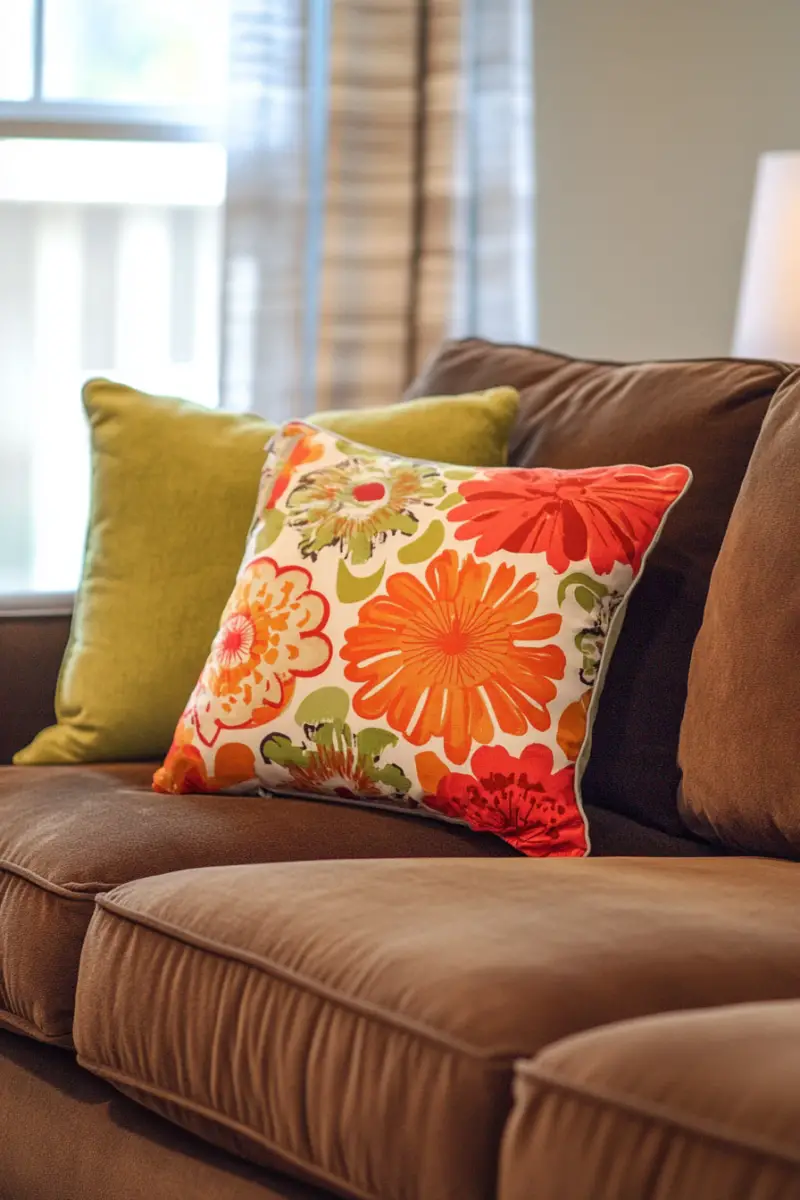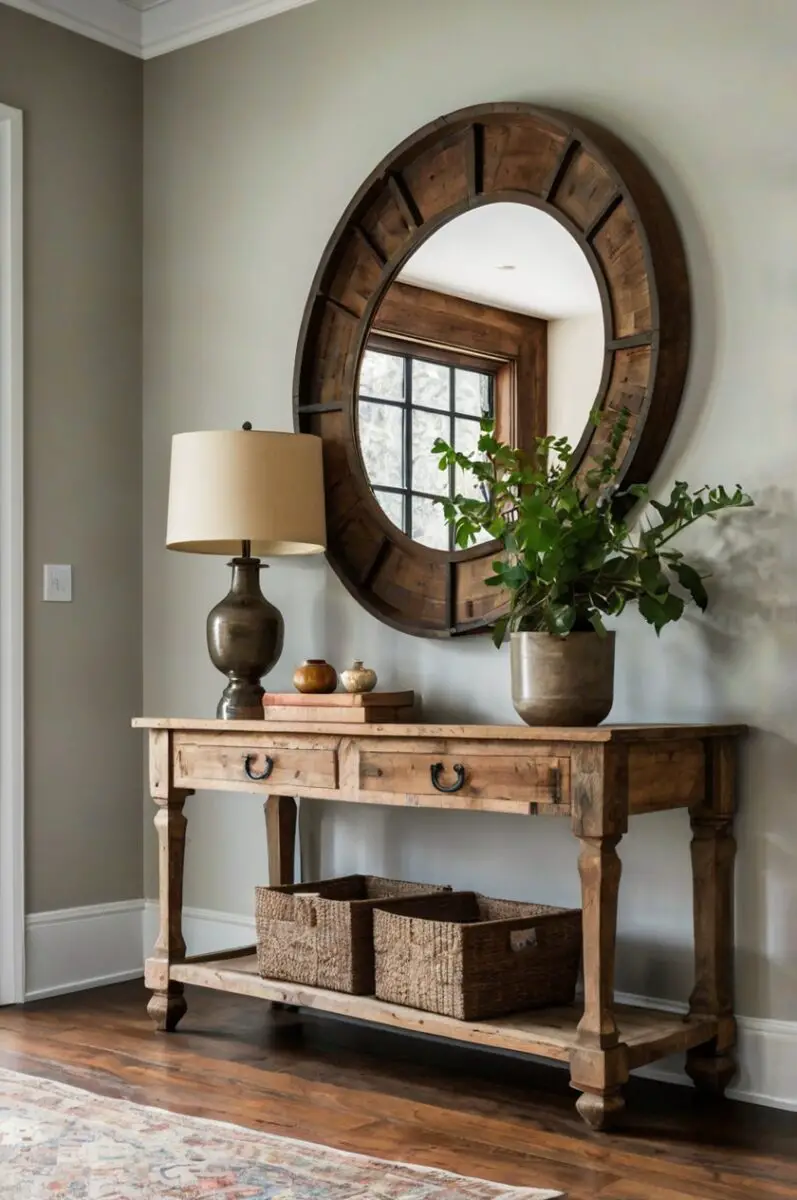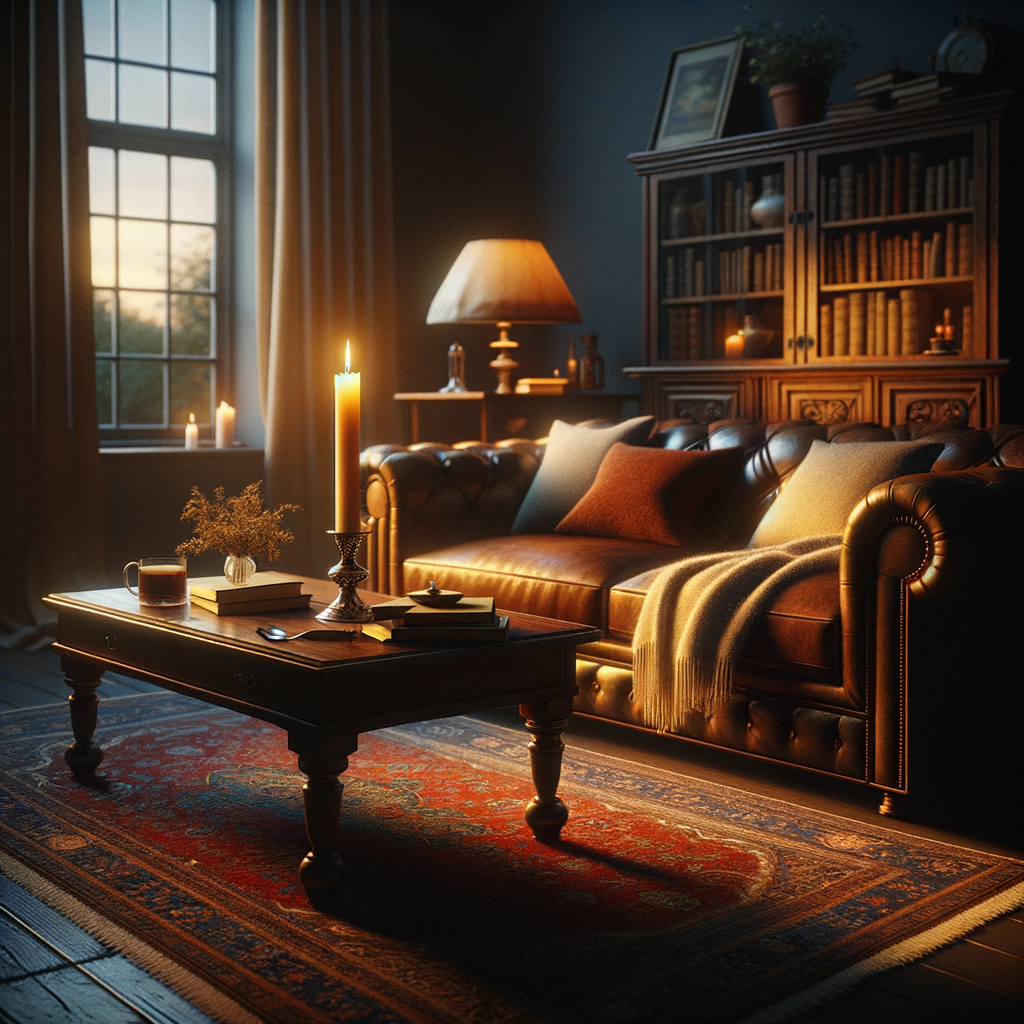As a designer, I’ve found that incorporating natural materials, organic textures, ambient lighting and thoughtful accents make an enormous difference in the lived-in feel of a home.
I’ll explore options ranging from throw pillows and area rugs to wall art and soft furnishings.
My hope is that these suggestions inspire you to elevate your decor and lift your living areas to new levels of relaxed charm.
A warm, comfortable home provides the perfect environment for making memories.
It’s my pleasure as a designer to provide you ideas to help achieve that for your own special space.
Let’s get started – I can’t wait to share my favorite aesthetic concepts for inviting interior warmth.
✨Click to Get My 101 FREE Designer Room Ideas
Add Throw Pillows and Blankets

Throw pillows and cozy blankets are a design essential for creating an invitingly warm home.
As a designer, I consider the texture, fabric, style and placement of these textiles carefully.
For pillows, I like to mix shapes, sizes and fabrics – perhaps a few oversized round pillows paired with some elongated rectangles.
Mixing soft materials like cable knit cotton, chunky woven wool or faux fur adds visual interest.
Coordinate colors and prints within a family to keep the look pulled together.
Draping blankets casually over the back of the couch or armchair signals welcome and ease.
I recommend choosing blankets large enough to truly wrap up in for maximum coziness.
Thoughtful pillow and blanket placement is also important.
I often stagger pillows down a sofa, leaning some against the arm to form a welcoming nook.
Draping multiple throws over furniture allows guests to choose their preferred weight and texture.
Proper lighting showcases the depth and warmth of textiles.
Ambient floor and table lamps highlight texture without being too bright.
Finally, accessibility is key – within easy reach so anyone can grab a pillow or blanket as desired.
Incorporate Natural Wood Furniture

I’m a strong proponent of using wood furniture to ground a space and introduce warmth.
Wood has an organic authenticity that feels instantly calming.
I recommend choosing furniture pieces made from wood varieties with subtle grain patterns, such as oak, walnut, or teak.
The warmer wood tones help mirror the colors found in nature.
Distressed or weathered woods with a lived-in patina further enhance this effortless aesthetic.
Not only does wood furniture provide durable structural frames, but its tactile quality can’t be beat.
The varying tones within each grain add visual appeal, and the natural material smells and feels great.
I advise mixing wood pieces of varying styles – from rigid square lines to curvy organic silhouettes – for visual balance.
Don’t be afraid to mix wood stains either, from light bleached blondes to rich chocolate browns.
Proper lighting displays the ever-changing qualities of wood best.
Finally, considering furniture placement allows wood tones to flow throughout a space for ultimate warmth and flow.
Use Area Rugs

I’m a strong advocate for incorporating plush area rugs throughout living spaces.
Beyond simply looking beautiful, rugs have numerous functional benefits for comfort and style.
Texture is key, so I suggest choosing rugs made from soft, cozy materials like wool, cotton, sisal, or seagrass.
Not only do these natural fibers feel amazing underfoot, but their varied textures and colors introduce visual layers.
For maximum warmth and cushioning, I recommend rugs with a 0.5 inch or higher pile.
When selecting sizes, err on generous – rugs should fully anchor furniture groupings without being too small.
Placement under furniture and in high-traffic areas prevents hard flooring from leeching away warmth.
Color and pattern also play a role.
Earthy tones like persimmon, olive and navy anchor while pops of tonal color lift the eye.
Abstract or floral prints introduce organic movement.
Regular professional cleaning keeps rugs fresh.
Proper rug pads are also important for acoustics, insulation, and safety.
With thoughtful consideration of materials, sizes, layering and placement, area rugs become a design focal point that ties together comfortable, inviting aesthetics underfoot.
Feature Plants

Beyond simply being a beautiful design element, studies show that plants have numerous benefits for physical and mental well-being.
When selecting plants, I consider light exposure, watering needs, toxicity for pets, proper potting and viable placement locations.
Tall tropicals like palms, ferns or dracaena often anchor entries and central rooms with oxygen-producing foliage.
Low-light philodendrons, pothos or snake plants thrive on shelves and windowsills.
For bright areas, try low-maintenance succulents in unique vessels or air-purifying peace lilies.
Consider scent and texture too – herbs like basil or lavender engage the senses.
Grouping plants together by watering schedules makes care efficient.
Pebbles in saucers prevent spills.
Organic, well-draining soils in breathable pots keep roots healthy.
Placements near energizing windows, soothing nooks or busy work areas promote wellness.
Plants on furniture, hanging from macrame or shelved create visual layers.
Dust foliage weekly to retain shine.
Inspect for pests and prune judiciously to maintain shape.
Rotating plant positions every few months prevents leaning toward light.
Live greenery is a small investment that pays huge sensory and atmospheric dividends all year.
✨Click to Get My 101 FREE Designer Room Ideas
Install Ambient Lighting

I place huge importance on lighting schemes that enhance warmth and comfort.
Ambient light allows visual layers throughout a home’s custom scheme.
For general illumination, I specify dimmable overhead fixtures to set a calm tone.
Wide shades broadcast soft light for activities.
Tunable whites mimic sunrise/sunset hues.
Task lighting prevents eyestrain.
Desk lamps, under-cabinet strips and sconces focus light where needed.
Accent lighting draws the eye aesthetically.
Flush or surface-mounted coves and soffits silhouette architectural details or reveal beam textures.
Floor and table lamps reduce overhead brightness.
Warm-colored bulbs in varying positions create a scattering of “firelight” ambiance without harsh directness.
Candle fixtures cast simulated flickering.
Choose scents and tapers proportionate to room scale.
Dimmers and timers help match lighting levels to activities and sunset.
Position sensors in utility areas prevent waste.
I specify luminaires crafted from warm materials like wood, metal and glass suitable for layered, focal installation.
Outdoor fixtures continue the inviting aesthetic beyond the home.
With meticulous lighting placement, the right fixtures and bulbs can enhance any interior space into a designed atmosphere of relaxation and invitation after dark.
Soft, ambient light truly completes the warm, welcoming design aesthetic.
Showcase Art with Nature Scenes

I’m a strong believer that art can immediately enhance a home’s atmosphere.
Displaying nature scenes through various mediums lifts the senses.
Fine art photography captures landscape details for contemplation.
Search for large-scale prints featuring textures like sand, water or foliage.
Frame in wood tones for an organic look.
Paintings with impressionist, realist or abstract styles immerse viewers within the scene.
Loosen canvases from the wall at an angle for visual flow between pieces.
Mirrors, when styled as floating art, reflect surrounding nature tones infinitely.
Place in clusters or arrange singularly above furniture.
For tactile interest, weave nature-inspired fiber art into vignettes.
Pair macramé hangings with driftwood shelves displaying pottery or figurines.
Change display themes by season.
Summer may showcase beach art while winter focuses on snowy forests.
Rotating artwork prevents visual redundancy.
Illuminate pieces delicately to accentuate colors and textures after dark.
Picture lights, sconces or floating shelves optimize natural scenes.
Use Candlelight

I’m a strong proponent of incorporating candlelight to enhance ambiance.
Beyond aesthetics, the act of lighting candles reduces stress and promotes well-being.
When selecting candles, I recommend natural, fragrance-free varieties that burn cleanly without soot.
Soy, vegetable and beeswax options are sustainable.
Consider vessel style and scale – pillars work well on surfaces while hurricanes tamp flickering on tables.
Use emergency lids for safety.
Layer tapers and floats of varying heights together in candelabras or wrought iron stands.
Groupings cast a romantic “fire” effect.
Flameless LED candles allow the same ambiance without risk.
Place tea lights in glass jars, hurricane shades or Lanterns for a luminous glow.
Strategically position candles throughout living spaces.
Foyers and dining rooms benefit from dramatic centerpieces.
Soothing nooks call for single tea lights.
Incorporate candlelight into design themes through colors, textures and scents.
Autumn may feature spice-scented flames in copper and wood vessels.
For atmosphere, dim overhead lights 30-50% when candles illuminate.
Consider rear-projection on shelves to emphasize flicker at eye level.
Through creative implementations, candlelight breathing life and energy into any interior long after sunset falls.
It’s integral to achieving restful warmth.
Curate a Book Collection

Properly displaying a treasured collection enhances atmosphere.
Carefully consider genres that reflect your lifestyle – coffee table books showcasing passions, fiction of varying styles, non-fiction spanning topics.
Assemble hardcovers, paperbacks and digitals together harmoniously.
Alike topics or colors create organized visual flow.
Built-in shelves maximize vertical space.
Seat them behind furniture for comfortable browsing.
Floating shelves allow curation by height.
Display books both spines out and opened face-out.
Themed vignettes around portraits or objects tell stories.
Bookends, bins and risers prevent slumping and showcase titles attractively.
Natural elements like wood and brass accent bookish elegance.
Illuminate carefully at night to appreciate bindings, photography and page textures leisurely.
Sconces and gooseneck lamps optimize the experience.
Foster a habit of reading curated collections for pleasure, enlightenment and living room functionality.
Rotate editions regularly to encompass interests.
Through thoughtful selection and creative presentation, books transform a generic entertainment wall into a cozy personal library promoting thought and relaxation.
✨Click to Get My 101 FREE Designer Room Ideas
Add Photo Displays

Careful planning creates impact.
Select images capturing milestones, travels, passions and relationships.
Mix sizes and styles organically like portraits, Polaroids and landscapes.
Frame choices reflect your personal aesthetic.
Simple wood, mixed metals and mats present photos beautifully without distracting.
Display frames both individually and in thoughtful groupings.
Cluster by theme, timeline or size cohesively on shelves, tables and walls.
Incorporate three-dimensional displays like step albums opened strategically, string-lined pictures or collages in reclaimed frames.
Customize interactive family boards posting recent photos with removable clings.
Encourage additions for shared memories.
Capture candid lifestyle shots featuring home interiors, recipes or hobbies to depict your everyday joy.
Change bi-annually coinciding with seasons or celebrations to relive different periods meaningfully.
Archival storage protects favorites long-term.
Through creative positioning and rotation, photo curation immerses viewers in treasured moments and fosters connection in any space it adorns.
Incorporate Soft Textiles

I believe textiles are integral to crafting an inviting atmosphere.
Considerations include tactile appeal, visual interest and functionality.
Curate an eclectic mix of natural fabrics like cotton, linen, wool and silk.
Exploration of weaves, patterns and textures enriches sensory experiences.
Incorporated textiles serve purpose beyond aesthetics.
Fluffy throws cozy seating, while cotton runners prevent drafts on floors.
Billowy linen curtains buffer outside noise.
Play with scale, mixing plush pillows, bed skirts and carpet pieces.
Oversized options offer additional surface texture.
Earth tones like burnt orange, olive and pale blue calm visually while allowing pops of color.
Monochromatic palettes flow cohesively.
Strategic layering across furnishings defines purposeful zones for various activities.
Tailored cushions support while tossed blankets invite respite.
Rotate pieces seasonally – cable knits by winter fires, seersucker cushions for summer indoors.
Adaptability prevents redundancy.
Prioritize easy care – stain-resistant cottons and quick drying fabrics maintain pleasant tactility through regular laundering.
Soft surfaces become design focal points that tie an entire space together in comfort and luxury through thoughtful implementation.
Resulting warmth enhances all other features.
Try Wood-Burning or Electric Fireplaces
For wood-burning models, clearances must meet code.
Chimneys and flues require professional installation and maintenance to prevent hazards.
Electric options run safely indoors or out.
Research realistic “flame” technology and fuel bed materials like log sets.
Integrated hearths blend seamlessly.
Floor, wall hung or built-in configurations suit various spaces.
Scale and materials match surrounding architecture naturally.
Natural stone, brick and wood-surrounds lend ambiance.
Distressed finishes emulates vintage charm.
Etch detailing or install custom trim for visual appeal.
Install high-definition screens framed by realistic materiality in zero-clearance setups within mantels.
Flickering LEDs mimic firelight perfectly.
Programmable thermostats and variable heat output provide balanced warmth and visual show.
Realistic crackling and glowing embers further fool the eye and ear.
Consider fireplace style, sizing and placement to define the home’s most inviting social zones for gathering year-round.
Hardscaping like stonework enhances overall coziness.
With properly executed details, a fireplace focal point becomes the heart any authentic home atmosphere.
Real or imitation, the effect soothes.
Allow for Comfy Seating
Seating is paramount to establishing a relaxing and inviting atmosphere.
Considerations include comfort, arrangement and purpose.
Sofas and loveseats provide central gathering areas near amenities like fireplaces and entertainment.
Select plush fabrics durable enough for frequent use.
Modular sectionals offer flexible configurations tailored to family size and activities.
Reclining options soothe.
Layer pillows, throws and ottomans for approachable spots to curl up with a book or nap.
Place squishy bean bags near windows.
Strategically mix pallet options – velvet armchairs by reading nooks, wicker by sunny porches, upholstered benches at kitchen islands.
Arrange conversation areas with sufficient spacing for movement yet intimacy.
Angle furniture toward focal points.
Designate solo seating for focused activities like laptop areas, makeup vanities and baths.
Incorporate swivel staples, accent chairs and poufs that invite occupying odd corners.
Consider lighting placement and decorative trays to facilitate easy entertainment from any seat.
Connect audio for relaxing ambiance.
Well-positioned, top-quality seating encourages dwelling and connecting meaningfully within cherished spaces.
Its comfort sets the tone.
Through thoughtful implementation of natural materials, curated displays, impactful lighting and soft textures, an inviting atmosphere can be cultivated in any home.
The intentional details discussed create visual delight and sensory pleasure that lift the spirits.
Personal touches reflecting one’s interests promote connection and comfort.
Simple adjustments like rotating artistry and incorporating greenery throughout the seasons maintain visual stimulation and breathe life annually.
Upkeep of soft surfaces and collections preserves an experience of luxury and leisure.
Most Importantly, considering how Space will be lived in and catering to real human needs of various homeowners is Paramount.
Comfortable Furniture, thoughtful displays and warm Details come together to make a house truly feel like a home – a refuge for the mind, body and soul.
When design uplifts the experience of inhabiting treasured spaces, it fulfills its deepest purpose.
A cozy, inviting atmosphere grounded in nature encourages dwelling richly within one’s surroundings.


